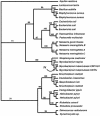Fatty acid biosynthesis in Mycobacterium tuberculosis: lateral gene transfer, adaptive evolution, and gene duplication
- PMID: 12917487
- PMCID: PMC193559
- DOI: 10.1073/pnas.1737230100
Fatty acid biosynthesis in Mycobacterium tuberculosis: lateral gene transfer, adaptive evolution, and gene duplication
Abstract
Mycobacterium tuberculosis is a high GC Gram-positive member of the actinobacteria. The mycobacterial cell wall is composed of a complex assortment of lipids and is the interface between the bacterium and its environment. The biosynthesis of fatty acids plays an essential role in the formation of cell wall components, in particular mycolic acids, which have been targeted by many of the drugs used to treat M. tuberculosis infection. M. tuberculosis has approximately 250 genes involved in fatty acid metabolism, a much higher proportion than in any other organism. In silico methods have been used to compare the genome of M. tuberculosis CDC1551 to a database of 58 complete bacterial genomes. The resulting alignments were scanned for genes specifically involved in fatty acid biosynthetic pathway I. Phylogenetic analysis of these alignments was used to investigate horizontal gene transfer, gene duplication, and adaptive evolution. It was found that of the eight gene families examined, five of the phylogenies reconstructed suggest that the actinobacteria have a closer relationship with the alpha-proteobacteria than expected. This is either due to either an ancient transfer of genes or deep paralogy and subsequent retention of the genes in unrelated lineages. Additionally, adaptive evolution and gene duplication have been an influence in the evolution of the pathway. This study provides a key insight into how M. tuberculosis has developed its unique fatty acid synthetic abilities.
Figures





Similar articles
-
Acyl-CoA carboxylases (accD2 and accD3), together with a unique polyketide synthase (Cg-pks), are key to mycolic acid biosynthesis in Corynebacterianeae such as Corynebacterium glutamicum and Mycobacterium tuberculosis.J Biol Chem. 2004 Oct 22;279(43):44847-57. doi: 10.1074/jbc.M408648200. Epub 2004 Aug 11. J Biol Chem. 2004. PMID: 15308633
-
Evolution of Mycolic Acid Biosynthesis Genes and Their Regulation during Starvation in Mycobacterium tuberculosis.J Bacteriol. 2015 Dec;197(24):3797-811. doi: 10.1128/JB.00433-15. Epub 2015 Sep 28. J Bacteriol. 2015. PMID: 26416833 Free PMC article.
-
AccD6, a key carboxyltransferase essential for mycolic acid synthesis in Mycobacterium tuberculosis, is dispensable in a nonpathogenic strain.J Bacteriol. 2011 Dec;193(24):6960-72. doi: 10.1128/JB.05638-11. Epub 2011 Oct 7. J Bacteriol. 2011. PMID: 21984794 Free PMC article.
-
Drugs that inhibit mycolic acid biosynthesis in Mycobacterium tuberculosis.Curr Pharm Biotechnol. 2002 Sep;3(3):197-225. doi: 10.2174/1389201023378328. Curr Pharm Biotechnol. 2002. PMID: 12164478 Review.
-
Lineage-specific differences in lipid metabolism and its impact on clinical strains of Mycobacterium tuberculosis.Microb Pathog. 2020 Sep;146:104250. doi: 10.1016/j.micpath.2020.104250. Epub 2020 May 11. Microb Pathog. 2020. PMID: 32407863 Review.
Cited by
-
Marginal vitamin B-6 deficiency decreases plasma (n-3) and (n-6) PUFA concentrations in healthy men and women.J Nutr. 2012 Oct;142(10):1791-7. doi: 10.3945/jn.112.163246. Epub 2012 Sep 5. J Nutr. 2012. PMID: 22955512 Free PMC article.
-
Recurring cluster and operon assembly for Phenylacetate degradation genes.BMC Evol Biol. 2009 Feb 10;9:36. doi: 10.1186/1471-2148-9-36. BMC Evol Biol. 2009. PMID: 19208251 Free PMC article.
-
Metabolic network motifs can provide novel insights into evolution: The evolutionary origin of Eukaryotic organelles as a case study.Comput Biol Chem. 2014 Dec;53PB:242-250. doi: 10.1016/j.compbiolchem.2014.09.006. Epub 2014 Sep 21. Comput Biol Chem. 2014. PMID: 25462333 Free PMC article.
-
Integrative Metabolomics to Identify Molecular Signatures of Responses to Vaccines and Infections.Metabolites. 2020 Nov 30;10(12):492. doi: 10.3390/metabo10120492. Metabolites. 2020. PMID: 33266347 Free PMC article. Review.
-
Transcriptional profiling of mycobacterium tuberculosis during infection: lessons learned.Front Microbiol. 2010 Nov 18;1:121. doi: 10.3389/fmicb.2010.00121. eCollection 2010. Front Microbiol. 2010. PMID: 21738523 Free PMC article.
References
-
- World Health Organization (2001) Stop TB Annual Report WHO/CDS/STB/2002.17 (W.H.O., Geneva).
-
- Cole, S. T., Brosch, R., Parkhill, J., Garnier, T., Churcher, C., Harris, D., Gordon, S. V., Eiglmeier, K., Gas, S., Barry, C. E., III, et al. (1998) Nature 393, 537-544. - PubMed
-
- Valway, S. E., Sanchez, M. P., Shinnick, T. F., Orme, I., Agerton, T., Hoy, D., Jones, J. S., Westmoreland, H. & Onorato, I. M. (1998) N. Engl. J. Med. 338, 633-639. - PubMed
-
- Betts, J. C., Dodson, P., Quan, S., Lewis, A. P., Thomas, P. J., Duncan, K. & McAdam, R. A. (2000) Microbiology 146, 3205-3216. - PubMed
-
- Wolf, Y. I., Rogozin, I. B., Grishin, N. V. & Koonin, E. V. (2002) Trends Genet. 18, 472-479. - PubMed
Publication types
MeSH terms
Substances
LinkOut - more resources
Full Text Sources
Miscellaneous

